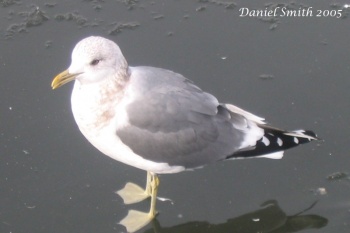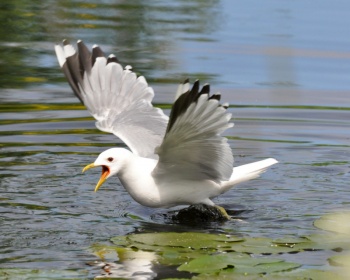Includes: Common Gull
- Larus canus
Identification
A fairly small white-headed gull, with small yellow bill, petite looks, broad white crescents on back, round head, white primary tips show well when standing, and usually dark brown iris. In winter, the head is lightly streaked with dark grey, and the bill often has a narrow dusky to diffuse black band. Juvenile to first summer have brownish-black primaries; head and body brown to whitish, often heavily streaked; mantle brown in juvenile, grey by first winter.
Similar Species
Ring-billed Gull is slightly larger with slightly lighter back, pale yellow iris, thicker bill with broad solid black ring, narrower white crescents on back, and less white on the primary tips. Juveniles have contrasting white belly and black primaries.
Distribution

Photo by DaninJapan
Shimoda-Machi, Aomori-Ken, Japan; February 2005
Breeds in northern Europe, northern Asia, and northwestern North America; migrates south during the winter. See subspecies, below, for detail.
Taxonomy
Its closest relative is Ring-billed Gull, and secondarily to the entire Herring Gull complex of large white-headed gulls.
Subspecies
Subdivided into four subspecies[1], one of which probably better treated as a separate species[2]:
- L. c. canus Common Gull. Abundant breeding species in northern Europe (Iceland, northwestern Ireland, Scotland, Netherlands, northern Germany, Scandinavia, Finland, Poland, the Baltic States, and Russia east to about 40°E longitude; wintering south and west to Ireland, Britain, France and northern Germany; small numbers as far south as Morocco. Abundant, with a population of around 500,000 pairs; after Black-headed Gull the commonest gull wintering in Britain, with 700,000 birds, with a northern bias.
- L. c. heinei Siberian Common Gull. Breeds in Russia and Kazakhstan from around 40°E to around 140°E longitude; wintering mainly in central Europe, the eastern Mediterranean, Black Sea, and southern Caspian Sea, though a few also west to Britain, and east with L. c. kamtschatschensis to the western Pacific. As L. c. canus, but mantle slightly darker.
- L. c. kamtschatschensis Kamchatka Gull. Breeds in north-eastern Siberia; winters western Pacific in Japan, Korea, northeastern China, and far southeastern Russia (Vladivostok area). As L. c. heinei, but larger, with a heavier bill; legs brighter yellow; iris often light brown in adults; size suggests a transition to Ring-billed Gull rather than Mew Gull[2]. Population not known, but common in Japan in winter.
- The above three subspecies are weakly defined, with broad zones of intergradation where they meet[2].
- L. c. brachyrhynchus Mew Gull (has also been called Short-billed Gull). Breeds in Alaska and western Canada; winters along west coast of North America from Alaska south to Baja California. Adult plumage similar to L. c. canus but with less black on wingtips, head more heavily streaked and bill with less black smudging in winter; iris mid brown, sometimes yellowish. Structure differs more, with longer wings and more rounded head, and bill shorter and weaker. Juvenile plumage markedly different, with uniform dusky brown head and underside, and brown wings. A scarce taxon, with a population of little over 10,000 pairs[2].
The once-split subspecies L. c. brachyrhynchus has now again been lumped with Larus canus[1]. The common name Mew Gull is recommended by all the major taxonomic authorities for the merged species, despite this not being the name of the nominate subspecies, and being far less widespread and abundant than Common Gull. The species continues to be known as Common Gull in Europe and Asia. The only world-wide authority to recognise the split of Mew Gull from Common Gull was the 1996 installment of Sibley and Monroe[3], though they are also treated as separate species in Olsen & Larsson's monograph (2003)[2], a trend likely to increase again in the future.
Habitat
Natural habitat by lakes and marshes in the breeding season and along coasts in winter; within last century or so has become strongly adapted to human commensalism, feeding on ploughed fields, meadows, and sports grounds, or in streets on human-supplied food, and using roofs in urban areas (particularly industrial estates) to nest and rest. Outside of the breeding season, often flies often long distances (up to 20-30 km) every evening to roost at sea or on large lakes and reservoirs.
Behaviour
Diet
Omnivorous. They scavenge as well as hunt small prey.
Breeding
They make a lined nest on the ground on islets in wetlands or on moorland, on large buildings (flat-roofed factories), or rarely, in a tree.
Vocalisation
<flashmp3>Larus canus (song).mp3</flashmp3>
Listen in an external program
References
- Clements, J. F., T. S. Schulenberg, M. J. Iliff, D. Roberson, T. A. Fredericks, B. L. Sullivan, and C. L. Wood. 2014. The eBird/Clements checklist of birds of the world: Version 6.9., with updates to August 2014. Downloaded from http://www.birds.cornell.edu/clementschecklist/download/
- Olsen, K. M., & Larsson, H. (2003). Gulls of Europe, Asia and North America. Helm ISBN 978-0-7136-7087-5
- Sibley, CG and BL Monroe. 1996. Birds of the World, on diskette, Windows version 2.0. Charles G. Sibley, Santa Rosa, CA, USA.
Recommended Citation
- BirdForum Opus contributors. (2025) Common Gull. In: BirdForum, the forum for wild birds and birding. Retrieved 26 April 2025 from https://www.birdforum.net/opus/Common_Gull
External Links









